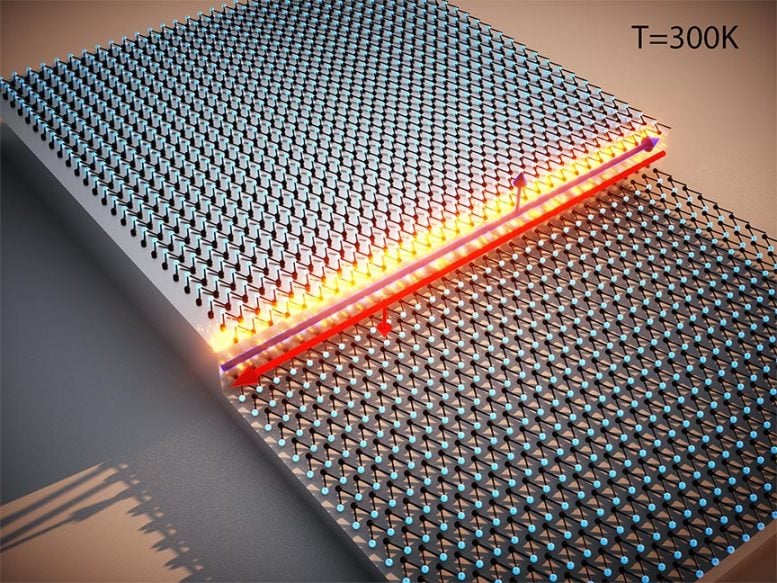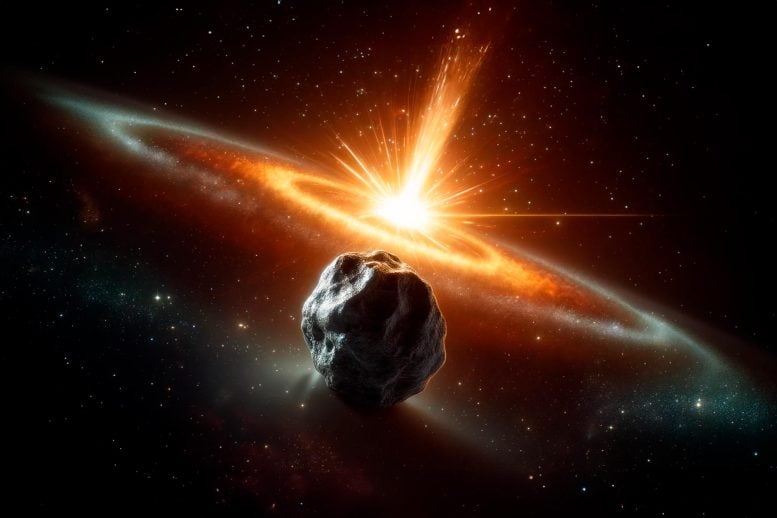Horoscopo
Físicos de Princeton descubren estado cuántico exótico a temperatura ambiente

Investigadores de Princeton han descubierto que un material conocido como aislante topológico, hecho de los elementos bismuto y bromo, exhibe comportamientos cuánticos especializados que normalmente solo se ven en condiciones experimentales extremas de altas presiones y temperaturas cercanas al cero absoluto. Crédito: Shafayat Hossain y el Sr. Zahid Hasan de la Universidad de Princeton
Por primera vez, los físicos han observado nuevos efectos cuánticos en un aislador topológico a temperatura ambiente.
Investigadores de[{» attribute=»»>Princeton University discovered that a material known as a topological insulator, made from the elements bismuth and bromine, exhibits specialized quantum behaviors normally seen only under extreme experimental conditions of high pressures and temperatures near absolute zero. The finding opens up a new range of possibilities for the development of efficient quantum technologies, such as spin-based, high-energy-efficiency electronics.
Physicists have observed novel quantum effects in a topological insulator at room temperature for the first time. This breakthrough came when scientists from Princeton University explored a topological material based on the element bismuth. The study was published as the cover article of the October issue of the journal Nature Materials.
While scientists have used topological insulators to demonstrate quantum effects for more than a decade, this experiment is the first time these effects have been observed at room temperature. Inducing and observing quantum states in topological insulators typically requires temperatures around absolute zero, which is equal to minus 459 degrees Fahrenheit (or -273 degrees Celsius).
This finding opens up a new range of possibilities for the development of efficient quantum technologies, such as spin-based electronics, which have the potential to replace many current electronic systems with substantially higher energy efficiency.
In recent years, the study of topological states of matter has attracted considerable attention among physicists and engineers. In fact, it is presently the focus of much international interest and research. This area of study combines quantum physics with topology — a branch of theoretical mathematics that explores geometric properties that can be deformed but not intrinsically changed.

M. Zahid Hasan. Credit: Princeton University
“The novel topological properties of matter have emerged as one of the most sought-after treasures in modern physics, both from a fundamental physics point of view and for finding potential applications in next-generation quantum engineering and nanotechnologies,” said M. Zahid Hasan, the Eugene Higgins Professor of Physics at Princeton University, who led the research. “This work was enabled by multiple innovative experimental advances in our lab at Princeton,” added Hasan.
A topological insulator is the main device component used to investigate the mysteries of quantum topology. This is a unique device that acts as an insulator in its interior, which means that the electrons inside are not free to move around and therefore do not conduct electricity. However, the electrons on the device’s edges are free to move around, meaning they are conductive. Moreover, because of the special properties of topology, the electrons flowing along the edges are not hampered by any defects or deformations. This device has the potential not only of improving technology but also of generating a greater understanding of matter itself by probing quantum electronic properties.
Until now, however, there has been a major stumbling block in the quest to use the materials and devices for applications in functional devices. “There is a lot of interest in topological materials and people often talk about their great potential for practical applications,” said Hasan, “but until some macroscopic quantum topological effect can be manifested at room temperature, these applications will likely remain unrealized.”
This is because ambient or high temperatures create what physicists call “thermal noise,” which is defined as a rise in temperature such that the atoms begin to vibrate violently. This action can disrupt delicate quantum systems, thereby collapsing the quantum state. In topological insulators, in particular, these higher temperatures create a situation in which the electrons on the surface of the insulator invade the interior, or “bulk,” of the insulator, and cause the electrons there to also begin conducting, which dilutes or breaks the special quantum effect.
The way around this is to subject such experiments to exceptionally cold temperatures, typically at or near absolute zero. At these incredibly low temperatures, atomic and subatomic particles cease vibrating and are consequently easier to manipulate. But creating and maintaining an ultra-cold environment is impractical for many applications; it is costly, bulky, and consumes a considerable amount of energy.
However, Hasan and his team have developed an innovative way to bypass this problem. Building on their experience with topological materials and working with many collaborators, they fabricated a new kind of topological insulator made from bismuth bromide (chemical formula α-Bi4Br4), which is an inorganic crystalline compound sometimes used for water treatment and chemical analyses.
“This is just terrific that we found them without giant pressure or an ultra-high magnetic field, thus making the materials more accessible for developing next-generation quantum technology,” said Nana Shumiya, who earned her Ph.D. at Princeton, is a postdoctoral research associate in electrical and computer engineering, and is one of the three co-first authors of the paper.
She added, “I believe our discovery will significantly advance the quantum frontier.”
The discovery’s roots lie in the workings of the quantum Hall effect — a form of topological effect that was the subject of the Nobel Prize in Physics in 1985. Since that time, topological phases have been intensely studied. Many new classes of quantum materials with topological electronic structures have been found, including topological insulators, topological superconductors, topological magnets, and Weyl semimetals.
While experimental discoveries were rapidly being made, theoretical discoveries were also progressing. Important theoretical concepts on two-dimensional (2D) topological insulators were put forward in 1988 by F. Duncan Haldane, the Sherman Fairchild University Professor of Physics at Princeton. He was awarded the Nobel Prize in Physics in 2016 for theoretical discoveries of topological phase transitions and a type of 2D topological insulators. Subsequent theoretical developments showed that topological insulators can take the form of two copies of Haldane’s model based on electron’s spin-orbit interaction.
Hasan and his team have been on a decade-long search for a topological quantum state that may also operate at room temperature, following their discovery of the first examples of three-dimensional topological insulators in 2007. Recently, they found a materials solution to Haldane’s conjecture in a kagome lattice magnet that is capable of operating at room temperature, which also exhibits the desired quantization.
“The kagome lattice topological insulators can be designed to possess relativistic band crossings and strong electron-electron interactions. Both are essential for novel magnetism,” said Hasan. “Therefore, we realized that kagome magnets are a promising system in which to search for topological magnet phases, as they are like the topological insulators that we discovered and studied more than ten years ago.”
“A suitable atomic chemistry and structure design coupled to first-principles theory is the crucial step to make topological insulator’s speculative prediction realistic in a high-temperature setting,” said Hasan. “There are hundreds of topological materials, and we need both intuition, experience, materials-specific calculations, and intense experimental efforts to eventually find the right material for in-depth exploration. And that took us on a decade-long journey of investigating many bismuth-based materials.
Insulators, like semiconductors, have what are called insulating, or band, gaps. These are in essence “barriers” between orbiting electrons, a sort of “no-man’s-land” where electrons cannot go. These band gaps are extremely important because, among other things, they provide the lynchpin in overcoming the limitation of achieving a quantum state imposed by thermal noise. They do this if the width of the band gap exceeds the width of the thermal noise. But too large a band gap can potentially disrupt the spin-orbit coupling of the electrons — this is the interaction between the electron’s spin and its orbital motion around the nucleus. When this disruption occurs, the topological quantum state collapses. Therefore, the trick in inducing and maintaining a quantum effect is to find a balance between a large band gap and the spin-orbit coupling effects.
Following a proposal by collaborators and co-authors Fan Zhang and Yugui Yao to explore a type of Weyl metals, Hasan and his team studied the bismuth bromide family of materials. But the researchers were not able to observe the Weyl phenomena in these materials. They instead discovered that the bismuth bromide insulator has properties that make it more ideal compared to a bismuth-antimony-based topological insulator (Bi-Sb alloys) that they had studied before. It has a large insulating gap of over 200 meV (“milli electron volts”). This is large enough to overcome thermal noise, but small enough so that it does not disrupt the spin-orbit coupling effect and band inversion topology.
“In this case, in our experiments, we found a balance between spin-orbit coupling effects and large band gap width,” said Hasan. “We found there is a ‘sweet spot’ where you can have relatively large spin-orbit coupling to create a topological twist as well as raise the band gap without destroying it. It’s kind of like a balance point for the bismuth-based materials that we have been studying for a long time.”
When the researchers viewed what was going on in the experiment through a sub-atomic resolution scanning tunneling microscope, they knew they had achieved their goal. This microscope is a unique device that uses a property known as “quantum tunneling,” where electrons are funneled between the sharp metallic, single-atom tip of the microscope and the sample. The microscope uses this tunneling current rather than light to view the world of electrons on the atomic scale. The team observed a clear quantum spin Hall edge state, which is one of the important properties that uniquely exist in topological systems. This required additional novel instrumentation to uniquely isolate the topological effect.
“For the first time, we demonstrated that there’s a class of bismuth-based topological materials that the topology survives up to room temperature,” said Hasan. “We are very confidant of our result.”
This finding is the culmination of many years of hard-won experimental work and required additional novel instrumentation ideas to be introduced in the experiments. Hasan has been a leading researcher in the field of experimental quantum topological materials with novel experimentation methodologies for over 15 years; and, indeed, was one of the field’s early pioneer researchers. Between 2005 and 2007, for example, he and his team of researchers discovered topological order in a three-dimensional bismuth-antimony bulk solid, a semiconducting alloy and related topological Dirac materials using novel experimental methods. This led to the discovery of topological magnetic materials. Between 2014 and 2015, they discovered a new class of topological materials called magnetic Weyl semimetals. The researchers believe this breakthrough will open the door to a whole host of future research possibilities and applications in quantum technologies.
“We believe this finding may be the starting point of future development in nanotechnology,” said Shafayat Hossain, a postdoctoral research associate in Hasan’s lab and another co-first author of the study. “There have been so many proposed possibilities in topological technology that await, and finding appropriate materials coupled with novel instrumentation is one of the keys for this.”
One area of research where Hasan and his team believe this breakthrough will have particular impact is on next-generation quantum technologies. The researchers believe this new breakthrough will hasten the development of more efficient, and “greener” quantum materials.
Currently, the theoretical and experimental focus of the group is concentrated in two directions, said Hasan. First, the researchers want to determine what other topological materials might operate at room temperature, and, importantly, provide other scientists the tools and novel instrumentation methods to identify materials that will operate at room and high temperatures. Second, the researchers want to continue to probe deeper into the quantum world now that this finding has made it possible to conduct experiments at higher temperatures.
These studies will require the development of another set of new instrumentations and techniques to fully harness the enormous potential of these materials. “I see a tremendous opportunity for further in-depth exploration of exotic and complex quantum phenomena with our new instrumentation, tracking more finer details in macroscopic quantum states,” Hasan said. “Who knows what we will discover?”
“Our research is a real step forward in demonstrating the potential of topological materials for energy-saving applications,” added Hasan. “What we’ve done here with this experiment is plant a seed to encourage other scientists and engineers to dream big.”
Reference: “Evidence of a room-temperature quantum spin Hall edge state in a higher-order topological insulator” by Nana Shumiya, Md Shafayat Hossain, Jia-Xin Yin, Zhiwei Wang, Maksim Litskevich, Chiho Yoon, Yongkai Li, Ying Yang, Yu-Xiao Jiang, Guangming Cheng, Yen-Chuan Lin, Qi Zhang, Zi-Jia Cheng, Tyler A. Cochran, Daniel Multer, Xian P. Yang, Brian Casas, Tay-Rong Chang, Titus Neupert, Zhujun Yuan, Shuang Jia, Hsin Lin, Nan Yao, Luis Balicas, Fan Zhang, Yugui Yao and M. Zahid Hasan, 14 July 2022, Nature Materials.
DOI: 10.1038/s41563-022-01304-3
The team included numerous researchers from Princeton’s Department of Physics, including present and past graduate students Nana Shumiya, Maksim Litskevich, Yu-Xiao Jiang, Zi-Jia Cheng, Tyler Cochran and Daniel Multer, and present and past postdoctoral research associates, Shafayat Hossain, Jia-Xin Yin and Qi Zhang. Other co-authors were Zhiwei Wang, Chiho Yoon, Yongkai Li, Ying Yang, Guangming Cheng , Yen-Chuan Lin, Brian Casas, Tay-Rong Chang, Titus Neupert , Zhujun Yuan, Shuang Jia , Hsin Lin and Nan Yao .
The work at Princeton was supported by the U.S. Department of Energy’s Basic Energy Sciences Division (and the Gordon and Betty Moore Foundation’s Emergent Phenomena in Quantum Systems Initiative.

Experiencia en periódicos nacionales y periódicos medianos, prensa local, periódicos estudiantiles, revistas especializadas, sitios web y blogs.
Horoscopo
Los científicos descubren una 'sorpresa' que cambia la comprensión del universo

Volver a los primeros días del universo parece algo que sólo sería posible en la ciencia ficción, pero los expertos han logrado encontrar algo muy lejano en las profundidades del tiempo y real.
Algunos de los astrónomos más importantes del mundo han descubierto algo «realmente sorprendente» ocurrido hace miles de millones de años que podría cambiar por completo la comprensión de nuestro universo.
Este es el resultado del estudio de los resultados de la cámara de infrarrojo cercano (NIRCam) del telescopio espacial James Webb de la NASA.
Esta tecnología extremadamente avanzada permite a los expertos estudiar las galaxias más antiguas del universo, dando una indicación de las condiciones que existían hace muchos, muchos años.
El universo tiene alrededor de 13,7 mil millones de años y un equipo de investigadores de la Universidad de Durham pudo observar datos conocidos como formación de barras apenas unos miles de millones de años después de que se formara el universo, lo cual es bastante sorprendente de comprender.
Esto es más que las observaciones anteriores del Telescopio Espacial Hubble, que ofrecen una visión de las condiciones de hace nueve mil millones de años.
Los hallazgos del equipo se publican en la revista. Avisos mensuales de la Royal Astronomical Society.
iStock
Los nuevos descubrimientos son más significativos que simplemente ofrecer una visión del pasado más lejana que antes. De hecho, la naturaleza de los hallazgos podría significar que es posible que sea necesario reevaluar nuestra comprensión de los primeros días del universo.
Esto se relaciona con las formaciones de barras, porque la presencia de estas formas más sedentarias es un indicador de ambientes más sedentarios, en comparación con la naturaleza más caótica de las galaxias durante su período de gestación anterior.
Zoe Le Conte es investigadora de doctorado en el Centro de Astronomía Extragaláctica del Departamento de Física de la Universidad de Durham y también es la autora principal de la investigación.
Le Conte dijo: “Las galaxias del universo primitivo están madurando mucho más rápido de lo que pensábamos. Esto es una verdadera sorpresa porque se esperaría que el universo en este punto fuera muy turbulento con muchas colisiones entre galaxias y mucho gas que aún no se ha convertido en estrellas.
“Sin embargo, gracias al Telescopio Espacial James Webb, estamos viendo muchas de estas barras mucho antes en la vida del Universo, lo que significa que las galaxias se encontraban en una etapa más avanzada de su evolución de lo que se pensaba anteriormente.
«Esto significa que tendremos que ajustar nuestra visión sobre la evolución temprana de las galaxias».
Inscribirse para nuestro boletín semanal gratuito indy100
Como unirse Canal gratuito de WhatsApp de Indy100
Exprésate en nuestra democracia mediática. Haga clic en el ícono de voto positivo en la parte superior de la página para ayudar a que este artículo ascienda en la clasificación de Indy100.

Experiencia en periódicos nacionales y periódicos medianos, prensa local, periódicos estudiantiles, revistas especializadas, sitios web y blogs.
Horoscopo
SpaceX lanza 23 satélites Starlink en el vuelo Falcon 9 desde Cabo Cañaveral – Spaceflight Now

Tras el histórico lanzamiento de dos satélites Galileo por parte de la Comisión Europea, SpaceX ha lanzado otro lote de sus propios satélites de Internet de alta velocidad Starlink. El lanzamiento del Falcon 9 el domingo por la noche marcó el 29º lanzamiento dedicado de satélites Starlink en 2024.
El despegue de la misión Starlink 6-54 desde el Complejo de Lanzamiento Espacial 40 (SLC-40) en la Estación Espacial de Cabo Cañaveral (CCSFS) tuvo lugar a las 6:08 p.m.EDT (2208 UTC).
El propulsor de primera etapa Falcon 9 que respalda esta misión, número de cola B1076 en la flota de SpaceX, se lanzó por decimotercera vez. Anteriormente apoyó los lanzamientos de Ovzon 3, Intelsat IS-40e, el vuelo número 26 de Servicios de Reabastecimiento Comercial (CRS-26) de SpaceX y seis misiones Starlink.
Poco más de ocho minutos después del despegue, B1076 aterrizó en el dron SpaceX, “Simplemente lea las instrucciones”. Este fue el aterrizaje número 80 del JRTI y el aterrizaje de refuerzo número 301 hasta la fecha.
En una publicación en las redes sociales, Kiko Dontchev, vicepresidente de lanzamiento de SpaceX, señaló que el equipo completó una rotación de cinco horas desde JRTI a Puerto Cañaveral entre la llegada y la salida del dron para apoyar la misión Starlink 6-54.
Los 23 satélites Starlink se suman a los 5.874 actualmente en órbita, según cifras compiladas el 24 de abril por el astrónomo y experto en seguimiento orbital Jonathan McDowell. Antes de este lanzamiento, se lanzaron 633 satélites Starlink en 2024.
El miércoles, SpaceX anunció que los Estados Federados de Micronesia, un país insular en el Océano Pacífico al este de Australia, fue el último país en agregarse a la lista de países donde el servicio Starlink está disponible.
Aterrizar y aterrizar en el dron Solo lee las instrucciones pic.twitter.com/qbVzhByVZZ
– EspacioX (@SpaceX) 28 de abril de 2024
Salida del dragón
El lanzamiento de Starlink 6-54 se produce apenas unas horas después de que SpaceX Cargo Dragon se separara de la Estación Espacial Internacional para comenzar su viaje de aproximadamente 36 horas para aterrizar frente a la costa de Florida. El desacoplamiento tuvo lugar a la 1:10 p. m. EDT (5:10 p. m. UTC).
El aterrizaje del martes por la mañana concluirá la misión CRS-30. Estuvo acoplado a la ISS durante más de 30 días y regresará con más de 4.000 libros de experimentos científicos.
La operación es también otro paso importante hacia el lanzamiento de la primera misión tripulada de Boeing al puesto orbital utilizando su nave espacial Starliner.
Antes de que pueda realizarse ese lanzamiento, SpaceX debe mover su nave espacial Crew Dragon Endeavour desde el puerto orientado hacia adelante al puerto orientado hacia el espacio del módulo Harmony. Esta maniobra debería tener lugar el 2 de mayo.

Experiencia en periódicos nacionales y periódicos medianos, prensa local, periódicos estudiantiles, revistas especializadas, sitios web y blogs.
Horoscopo
Descubrimiento sin precedentes en meteoritos desafía los modelos astrofísicos

Los investigadores han descubierto una rara partícula de polvo en un meteorito, formada por una estrella distinta de nuestro sol. Utilizando tomografía avanzada con sonda atómica, analizaron la proporción única de isótopos de magnesio de la partícula, revelando su origen a partir de un tipo recientemente identificado de supernova que quema hidrógeno. Este avance proporciona una mejor comprensión de los eventos cósmicos y la formación de estrellas. Crédito: SciTechDaily.com
Los científicos han descubierto una partícula de meteorito con una proporción de isótopos de magnesio sin precedentes, lo que apunta a su origen en una supernova que quema hidrógeno.
La investigación ha descubierto una rara partícula de polvo atrapada en un antiguo meteorito extraterrestre formado por una estrella distinta a nuestro sol.
El descubrimiento fue realizado por la autora principal, la Dra. Nicole Nevill y sus colegas durante sus estudios de doctorado en la Universidad de Curtin, quienes actualmente trabajan en el Instituto de Ciencias Lunares y Planetarias en colaboración con NASAen el Centro Espacial Johnson.
Meteoritos y granos presolares
Los meteoritos están formados principalmente por materiales formados en nuestro sistema solar y también pueden contener pequeñas partículas de estrellas nacidas mucho antes que nuestro sol.
Las pistas de que estas partículas, llamadas granos presolares, son reliquias de otras estrellas, se descubren analizando los diferentes tipos de elementos que contienen.
Técnicas analíticas innovadoras
El Dr. Nevill utilizó una técnica llamada átomo Sonda tomográfica para analizar la partícula y reconstruir la química a escala atómica, accediendo a la información escondida en su interior.
«Estas partículas son como cápsulas del tiempo celestes y proporcionan una instantánea de la vida de su estrella madre», dijo el Dr. Nevill.
“Los materiales creados en nuestro sistema solar tienen proporciones de isótopos predecibles: variantes de elementos con diferente número de neutrones. La partícula que analizamos tiene una proporción de isótopos de magnesio distinta de cualquier otra cosa en nuestro sistema solar.
“Los resultados fueron literalmente fuera de este mundo. La proporción de isótopos de magnesio más extrema, de estudios anteriores de granos presolares, fue de alrededor de 1.200. El grano en nuestro estudio tiene un valor de 3.025, que es el valor más alto jamás descubierto.
«Esta proporción de isótopos excepcionalmente alta sólo puede explicarse por la formación de un tipo de estrella recientemente descubierta: una supernova que quema hidrógeno».
Avances en astrofísica
El coautor, el Dr. David Saxey, del Centro John de Laeter en Curtin, dijo que la investigación innova la forma en que entendemos el universo, ampliando los límites de las técnicas analíticas y los modelos astrofísicos.
«La sonda atómica nos proporcionó un gran nivel de detalle al que no habíamos podido acceder en estudios anteriores», afirmó el Dr. Saxey.
“La supernova que quema hidrógeno es un tipo de estrella que se descubrió recientemente, casi al mismo tiempo que estábamos analizando la pequeña partícula de polvo. El uso de la sonda atómica en este estudio proporciona un nuevo nivel de detalle que nos ayuda a comprender cómo se formaron estas estrellas.
Vinculando los resultados de laboratorio con los fenómenos cósmicos
El coautor, el profesor Phil Bland de la Escuela de Ciencias Planetarias y de la Tierra de Curtin, dijo que los nuevos descubrimientos del estudio de partículas raras en meteoritos nos permiten comprender mejor los eventos cósmicos más allá de nuestro sistema solar.
«Es simplemente asombroso poder relacionar mediciones a escala atómica en el laboratorio con un tipo de estrella recientemente descubierta».
La investigación titulada “Elemento a escala atómica y estudio isotópico de 25Polvo estelar rico en magnesio procedente de una supernova que quema hidrógeno » fue publicado en el Revista de astrofísica.
Referencia: “Elemento a escala atómica y estudio isotópico de 25Mg-rich Stardust from an H-burning Supernova” por ND Nevill, PA Bland, DW Saxey, WDA Rickard, P. Guagliardo, NE Timms, LV Forman, L. Daly y SM Reddy, 28 de marzo de 2024, La revista de astrofísica.
DOI: 10.3847/1538-4357/ad2996

Experiencia en periódicos nacionales y periódicos medianos, prensa local, periódicos estudiantiles, revistas especializadas, sitios web y blogs.
-
Horoscopo3 años ago
Horóscopo: ¿qué dice tu ascendente para hoy y el fin de semana del 27 de noviembre?
-
Ciencia y tecnología3 años ago
Localizan la región de Marte más apropiada para la existencia de vida.
-
Entretenimiento2 años ago
¿Britney Spears y Sam Asghari están casados? Planes después de la conservación
-
Negocios3 años ago
Reguladores federales investigan bolsas de aire en vehículos 30M
-
Deportes5 meses ago
Vista previa: Perú vs Brasil – predicciones, noticias del equipo, alineaciones
-
Horoscopo3 años ago
Paseo espacial estadounidense fuera de la Estación Espacial Internacional pospuesto debido a un problema médico con el astronauta
-
Entretenimiento3 años ago
Eva Longoria, Shonda Rhimes y Jurnee Smollett abandonan la junta de Time’s Up: «Listos para un nuevo liderazgo»
-
Deportes4 meses ago
Kyogo Furuhashi anota y Japón venció a El Salvador 6-0 en un amistoso | Noticias de futbol








